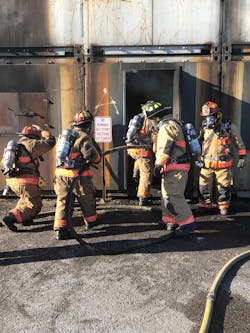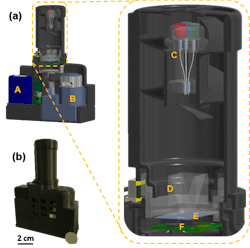Download the full PDF SMARTER: Advancing Health-Related Technology here.
Smoke is ubiquitous on the fireground. Recently, we have come to better understand the composition of smoke and all of its components, including particulate matter (PM). PM with a general diameter of 10μm or smaller, called PM10, can cause serious health problems as it can become lodged deep in the lungs and enter the bloodstream. The PM2.5 category represents particles with a diameter of 2.5μm or smaller and has been declared a cause of cancer by the World Health Organization.1
Currently, state-of-the-art PM monitoring is performed by stationary instruments, such as beta-attenuation monitoring (BAM) systems, which are bulky and expensive. Various commercial portable devices are also available, although they focus primarily on counting particles in several size ranges.2 PM from fires has a unique chemical composition and morphology,3 and a more detailed analytical approach may improve understanding of PM and the dangers it presents.
Introducing c-Air
Recently, we have performed a successful validation experiment estimating the number of PM with c-Air running alongside a BAM system, with the particle counts closely tracking each other.5 Furthermore, we have also demonstrated the accuracy of c-Air estimating the size of particles with approximately 93 percent accuracy.5 And we have successfully demonstrated the application of c-Air to monitoring and tracking the evolution of PM concentration and morphological features during a live wildfire.6 These results showed that the c-Air system can be used for accurate PM measurement and characterization, while offering a portable and inexpensive alternative to existing state-of-the-art systems.
Using c-Air on structural burns
Unlike wildfires, structural fires often produce PM of non-biological origin, which may also include additional toxic particles and chemicals. Recently, in collaboration with our colleagues—Dr. Denise Smith and her team from Skidmore College, as well as Shawn Brimhall, a fire protection specialist from the Division of Homeland Security and Emergency Services, State of New York—we have performed experiments with c-Air during several structural burns with the objective to monitor PM distribution and morphology during an extended post-suppression period (representing overhaul).
The first five burns were wood-based, followed by two wood pallets (100–120 pounds of class A material). The last three burns were “sofa”-based and each included overstuffed material with plywood composite, polyurethane foam, and synthetic materials over the top.
Looking ahead
We are continuing to develop the device to improve durability, increase range of PM concentrations, and extend analysis to vapor particles as well as solid phase or particles. Our goal is ultimately to provide firefighters with a low-cost portable monitor that measures PM concentration and its characteristics during emergency operations.
To learn more about c-Air and Dr. Aydogan Ozcan’s research lab, visit innovate.ee.ucla.edu/welcome.html and org.ee.ucla.edu.
To learn more about the SMARTER project and related studies, please visit skidmore.edu/responder.
More from SMARTER: Advancing Health-Related Technology
- Technology to Aid the Fire Service
- ECG Monitoring During Fireground Operations
- Heat Stress Algorithm
- Physiological Status Monitoring in Training
References
1. Loomis, D., Grosse, Y., Lauby-Secretan, B., et al. "The carcinogenicity of outdoor air pollution." Lancet Oncol. 2013; 14: 1262–1263.
2. Model 804 Handheld Particle Counter | Met One Instruments. Available at: metone.com/products/indoor-particle-monitors/model-804 (accessed: 08/13/2018).
3. Lighty, J.S., Veranth, J.M. and Sarofim, A.F., “Combustion Aerosols: Factors Governing Their Size and Composition and Implications to Human Health,” J. Air Waste Manag. Assoc. 2000. 50(9),1565–1618.
4. McLeod, E. and Ozcan, A., “Unconventional methods of imaging: computational microscopy and compact implementations." 2016. Rep. Prog. Phys. 79(7), 076001.
5. Wu, Y., Shiledar, A., Li, Y., et al. "Air Quality Monitoring Using Mobile Microscopy and Machine Learning.” 2017. Light: Science & Applications 6, page e17046, doi: 10.1038/lsa.2017.46.
6. Wu, Y., Shiledar, A., Wong, J., et al. “Spatial mapping and analysis of aerosols during a forest fire using computational mobile microscopy." 2018. Proc. SPIE 10485, Optics and Biophotonics in Low-Resource Settings IV, 104850T; doi: 10.1117/12.2288889.
About the Author
Maxim Batalin
Maxim Batalin, PhD, is an associate director at the UCLA Engineering Institute for Technology Advancement working with the UCLA Ozcan Research Group on new program development and project management. Batalin is focusing on the area of intelligent system innovations with applications to biomedical, environmental and sensor/actuator networks fields.
Aydogan Ozcan
Aydogan Ozcan, PhD, is the chancellor’s professor at UCLA and an HHMI Professor with the Howard Hughes Medical Institute, leading the Bio- and Nano-Photonics Laboratory at UCLA Electrical Engineering and Bioengineering Departments, and is also the associate director of the California NanoSystems Institute (CNSI) at UCLA.
Yichen Wu
Yichen Wu is a PhD candidate at the Bio-Photonics Lab led by Professor Aydogan Ozcan in the ECE Department at UCLA. His research focuses on combining computational algorithms with optics to build novel imaging and sensing tools, and their applications in biomedical diagnosis and air quality monitoring.


